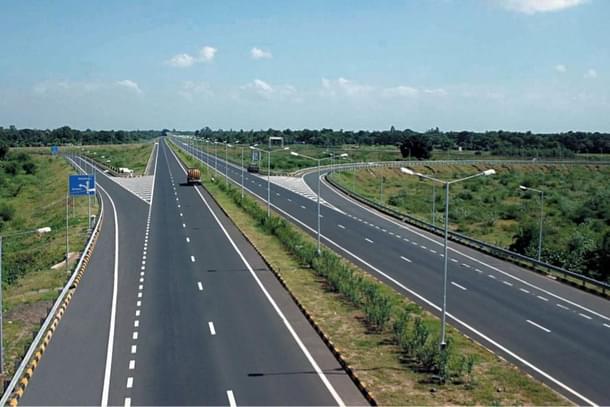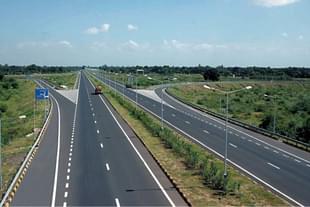Infrastructure
The Real Deficit In Infra Is Not Funds, But Inverted Power Structures
R Jagannathan
Feb 02, 2020, 11:32 AM | Updated Feb 10, 2020, 02:56 PM IST
Save & read from anywhere!
Bookmark stories for easy access on any device or the Swarajya app.


India’s huge infrastructure deficit is usually seen as a problem of inadequate funding. Finance Minister Nirmala Sitharaman, in her budget presented last year, mentioned a Rs 100 lakh crore investment requirement over five years, but this is likely to be an underestimate.
Add up our need for roads, ports, airports, railway tracks, electrification, water supply and sewage, optic fibre cables, and social and soft infrastructure in areas like education, health, judiciary, law enforcement and such-like things, it is unlikely that Rs 100 lakh crore is going to be anywhere near enough.
And we have not even mentioned defence and internal security infrastructure, including infrastructure for cyber policing, so far.
Infrastructure is both the problem and the solution for India’s economic woes. If India finds the money for building world-class infrastructure in all the above areas, we will become a $10 trillion economy by 2030-31 easily.
Growth will happen automatically, and jobs will start sprouting everywhere. All of Asia’s miracle economies, from the Asian tigers to the Chinese Dragon, built their economies through heavy capital spending in infrastructure. It is investment that ultimately drives growth and jobs, not just consumption.
But it is ultimately not about the money. Even if Indian banks won’t lend for infrastructure, even if we do not have a corporate bond market to support infra financing, even if the government does not earn enough by way of taxes to subsidise infrastructure building, the one big global reality is that the world is awash with capital.
Billions of dollars of corporate surpluses are being invested in low-yielding US treasury bonds for rates as low at 1.75 per cent for 10-year stock.
If some sort of cheap hedging mechanism can be provided by the government, a lot of the global surpluses can come into Indian infrastructure.
To repeat, India’s infrastructure problem is not about money, except for the lack of imaginative thinking around it.
Our real problem lies elsewhere, in the counter-productive constitutional and political structures we have created over the last seven decades, where power is misaligned from responsibility.
Put simply, economic power is concentrated at the Centre; political and administrative power converges around states; and neither power nor resources are available to political structures at the bottom of the pyramid — the metropolitan authorities, municipal corporations, zilla parishads and panchayats.
Between the Centre and the states, they have usurped all the power, while the real responsibility of making a difference to people’s day-to-day lives rests with local governments.
Take a simple example — urban infrastructure. The reality is that our cities, which create loads of wealth and jobs, are disempowered, and incapable of building the infrastructure themselves through their own efforts, including local taxation and by raising municipal debt on reasonable terms.
This is why we have needed a centrally-sponsored Jawaharlal Nehru National Urban Renewal Mission to fund roads and metros and sewage.
It is a joke that a city like Mumbai, which is home to some of the wealthiest taxpayers and billionaires, cannot fund its own infrastructure needs.
This adverse power-versus-responsibility structure is not only an incongruity between the Centre and the states, but also between states and their local bodies, whether metropolitan cities or zilla parishads or panchayats.
In Maharashtra, for example, Chief Minister Uddhav Thackeray desired the Urban Development portfolio more than Finance or Home, which went to his alliance partners.
Why did he do so? Because he wanted to keep control of urban funding with himself. For a Chief Minister whose power base is largely urban, it would have made far more sense to empower the two municipal corporations of Mumbai and Thane, which the Shiv Sena runs, than to try and control the funding at the level of Chief Minister.
A Chief Minister has to run an entire state, both urban and rural areas, and not just the urban areas. What happens when Uddhav loses the Chief Minister’s job some time in the future?
Conclusion No 1: If we want to find money for infrastructure, we must begin to address the problem by devolving resource-raising power to the level where the money is needed.
The Goods and Services Tax (GST), a transformative tax intended to reduce the need for multiple taxes at the state and local levels, has one major drawback. Since it replaces local taxes like octroi, entry tax, etc, it shifts financial power from local bodies upwards to the state administration.
Even though the Maharashtra government will reimburse the Municipal Corporation of Greater Mumbai (MCGM) for the loss of octroi revenues by guaranteeing it an eight per cent annual increase in terms of devolved revenue, the essential point is that various municipalities in the state are now dependent on state handouts for their finances.
Even a thing like stamp duty on property transactions is determined at the state level and not the municipal level.
If the average municipality does not have the cash flows and financial strength to start paying for its own infrastructure, where is the scope for raising debt through municipal bonds, which again will indirectly have to be guaranteed by the state government?
An inverted economic power structure, where resources are raised higher up in the political economy when most responsibility for infrastructure building rests lower down, effectively reduces even powerful cities to beggars.
Mumbai, the country’s richest city, produces seven per cent of India’s GDP, but is now reduced to seeking handouts from the state and the Centre.
Conclusion 2: The GST cannot just be a deal between the Centre and the states; there needs to be an urban and local body element in the rate structure where resources devolve automatically to the bottom-most layer of governance without the states playing middlemen.
Middlemen do not serve any purpose beyond taking a cut from any deal between two parties. What can be done through technology should not be left to middlemen politicians who may not have the best interests of either urban or rural areas at heart.
The next requirement is the creation of the right political structures for India. The parliamentary system does not work, for it again divorces power from responsibility. At the Centre, the Prime Minister derives his authority not from voters, but elected members of his party.
Narendra Modi may be an exception to this rule due to his extreme popularity with voters, but most Prime Ministers may not be so lucky even if elected by the majority.
To have high levels of governance, whether at the Centre, state or local body levels, we need to have a presidential system of accountability where voters elect the person they want and demand governance and delivery of services, especially public infrastructure in several areas.
Our current system of governance makes the corporator, legislator and parliamentarian excessively dependent on money power to get elected, when the actual job of delivering governance is with the Chief Executive and his key appointees.
Elected legislators spend a lot of their time trying to figure out how they will finance the next election, which means public good will come much later in their list of priorities.
A shift to a system of directly elected executive presidents, governors or mayors ought to be India’s answer to the problem of poor governance. The elected person must have the power to deliver, and this is particularly important when it comes to providing public goods like infrastructure.
In the current legislator-driven first-past-the-post electoral system, political parties focus more on providing private goods — freebies to the poor, special benefits to certain castes, etc — since this is what gets them an aggregation of sectarian votes.
In an executive presidency, the winner would have to obtain more than half the popular vote to have adequate democratic legitimacy to govern on behalf of all people.
It also means that sectional interests will not have a veto on infrastructure and other proposals that are good for everybody, but do not have caste or religious groups backing them.
Another mindshift we need to make when it comes to infrastructure is public-private partnerships. When we talk of public-private partnerships, we think private parties will bring in the money to supplement what the state cannot afford to finance.
This is unlikely to happen, given the parlous state of private promoter finances over the last few years.
Given the high cost of assets like land, it is the public that will have to finance these. Private parties can at best bring in expertise and management skills to make a project cost-efficient and viable.
This is as true for roads as schools or hospitals. The Right to Education Act wrongly casts the burden of educating the masses on private schools, when the attempt should be to keep the education infrastructure of state schools in public hands, but bring in private expertise to improve the quality of learning outcomes.
The state can own school buildings and playgrounds, but schooling can be infinitely better if left in private hands.
On the other hand, when foreign capital is given a free hand in infrastructure building, the scope for public-private partnership can change.
Foreign players do not lack capital; what they may be interested in is quick decision-making and elimination of regulatory hurdles and corruption.
They may also need low-cost exchange rate hedging mechanisms.
Conclusion 3: Infrastructure can be built through public-private partnerships, but we need a better understanding of what this means in the case of cash-strapped Indian businessmen and less cash-strapped foreign players.
A Chinese or Japanese infrastructure builder has the money, but not the patience to deal with an Indian bureaucracy. An Indian private partner may have the patience of an elephant, but not the resources to build infrastructure on his own.
India’s problem is not resources to build infrastructure; it is not having the right power structures and institutional mechanisms to get them built quickly and efficiently.
Jagannathan is former Editorial Director, Swarajya. He tweets at @TheJaggi.




